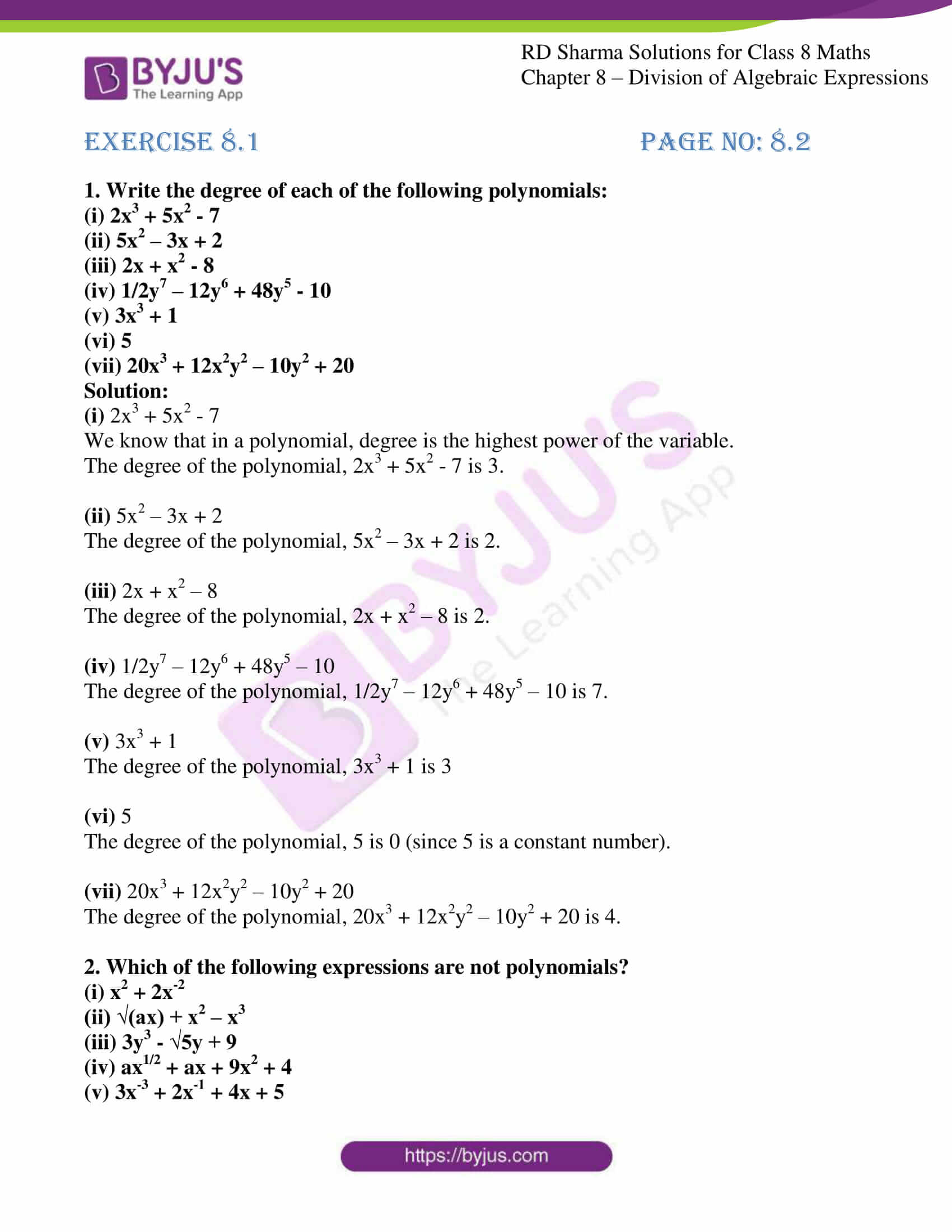The first exercise of Chapter 8 provides basic definitions of the terms used in this chapter, and we also find the degree of a polynomial in one variable and two variables. BYJU’S expert team has designed the RD Sharma Solutions for Class 8 Maths Exercise 8.1 Chapter 8 Division of Algebraic Expressions to help students prepare for their exams easily. RD Sharma Solutions is one of the best reference materials for CBSE students. Students can download the solutions in PDF from the links provided below.
RD Sharma Solutions for Class 8 Maths Exercise 8.1 Chapter 8 Division of Algebraic Expressions
Access Answers to RD Sharma Solutions for Class 8 Maths Exercise 8.1 Chapter 8 Division of Algebraic Expressions
EXERCISE 8.1 PAGE NO: 8.2
1. Write the degree of each of the following polynomials:
(i) 2x3 + 5x2 – 7
(ii) 5x2 – 3x + 2
(iii) 2x + x2 – 8
(iv) 1/2y7 – 12y6 + 48y5 – 10
(v) 3x3 + 1
(vi) 5
(vii) 20x3 + 12x2y2 – 10y2 + 20
Solution:
(i) 2x3 + 5x2 – 7
We know that in a polynomial, the degree is the highest power of the variable.
The degree of the polynomial, 2x3 + 5x2 – 7, is 3.
(ii) 5x2 – 3x + 2
The degree of the polynomial, 5x2 – 3x + 2, is 2.
(iii) 2x + x2 – 8
The degree of the polynomial, 2x + x2 – 8, is 2.
(iv) 1/2y7 – 12y6 + 48y5 – 10
The degree of the polynomial, 1/2y7 – 12y6 + 48y5 – 10, is 7.
(v) 3x3 + 1
The degree of the polynomial, 3x3 + 1, is 3
(vi) 5
The degree of the polynomial 5 is 0 (since 5 is a constant number).
(vii) 20x3 + 12x2y2 – 10y2 + 20
The degree of the polynomial, 20x3 + 12x2y2 – 10y2 + 20, is 4.
2. Which of the following expressions are not polynomials?
(i) x2 + 2x-2
(ii) √(ax) + x2 – x3
(iii) 3y3 – √5y + 9
(iv) ax1/2 + ax + 9x2 + 4
(v) 3x-3 + 2x-1 + 4x + 5
Solution:
(i) x2 + 2x-2
The given expression is not a polynomial.
Because a polynomial does not contain any negative powers or fractions.
(ii) √(ax) + x2 – x3
The given expression is not a polynomial.
Because the polynomial has 1/2 as the power of variable x, which is not a non-negative integer.
(iii) 3y3 – √5y + 9
The given expression is a polynomial.
Because the polynomial has positive powers.
(iv) ax1/2 + ax + 9x2 + 4
The given expression is not a polynomial.
Because a polynomial does not contain any negative powers or fractions.
(v) 3x-3 + 2x-1 + 4x + 5
The given expression is not a polynomial.
Because a polynomial does not contain any negative powers or fractions.
3. Write each of the following polynomials in the standard form. Also, write their degree.
(i) x2 + 3 + 6x + 5x4
(ii) a2 + 4 + 5a6
(iii) (x3 – 1) (x3 – 4)
(iv) (y3 – 2) (y3 + 11)
(v) (a3 – 3/8) (a3 + 16/17)
(vi) (a + 3/4) (a + 4/3)
Solution:
(i) x2 + 3 + 6x + 5x4
The standard form of the polynomial is written in either increasing or decreasing order of their powers.
3 + 6x + x2 + 5x4 or 5x4 + x2 + 6x + 3
The degree of the given polynomial is 4.
(ii) a2 + 4 + 5a6
The standard form of the polynomial is written in either increasing or decreasing order of their powers.
4 + a2 + 5a6 or 5a6 + a2 + 4
The degree of the given polynomial is 6.
(iii) (x3 – 1) (x3 – 4)
x6 – 4x3 – x3 + 4
x6 – 5x3 + 4
The standard form of the polynomial is written in either increasing or decreasing order of their powers.
x6 – 5x3 + 4 or 4 – 5x3 + x6
The degree of the given polynomial is 6.
(iv) (y3 – 2) (y3 + 11)
y6 + 11y3 – 2y3 – 22
y6 + 9y3 – 22
The standard form of the polynomial is written in either increasing or decreasing order of their powers.
y6 + 9y3 – 22 or -22 + 9y3 + y6
The degree of the given polynomial is 6.
(v) (a3 – 3/8) (a3 + 16/17)
a6 + 16a3/17 – 3a3/8 – 6/17
a6 + 77/136a3 – 48/136
The standard form of the polynomial is written in either increasing or decreasing order of their powers.
a6 + 77/136a3 – 48/136 or -48/136 + 77/136a3 + a6
The degree of the given polynomial is 6.
(vi) (a + 3/4) (a + 4/3)
a2 + 4a/3 + 3a/4 + 1
a2 + 25a/12 + 1
The standard form of the polynomial is written in either increasing or decreasing order of their powers.
a2 + 25a/12 + 1 or 1 + 25a/12 + a2
The degree of the given polynomial is 2.



Comments